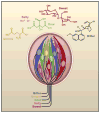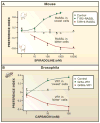Common sense about taste: from mammals to insects
- PMID: 19837029
- PMCID: PMC3936514
- DOI: 10.1016/j.cell.2009.10.001
Common sense about taste: from mammals to insects
Abstract
The sense of taste is a specialized chemosensory system dedicated to the evaluation of food and drink. Despite the fact that vertebrates and insects have independently evolved distinct anatomic and molecular pathways for taste sensation, there are clear parallels in the organization and coding logic between the two systems. There is now persuasive evidence that tastant quality is mediated by labeled lines, whereby distinct and strictly segregated populations of taste receptor cells encode each of the taste qualities.
Figures





References
-
- Adler E, Hoon MA, Mueller KL, Chandrashekar J, Ryba NJ, Zuker CS. A novel family of mammalian taste receptors. Cell. 2000;100:693–702. - PubMed
-
- Al-Anzi B, Tracey WD, Jr, Benzer S. Response of Drosophila to wasabi is mediated by painless, the fly homolog of mammalian TRPA1/ANKTM1. Curr Biol. 2006;16:1034–1040. - PubMed
-
- Amrein H, Thorne N. Gustatory perception and behavior in Drosophila melanogaster. Curr Biol. 2005;15:R673–R684. - PubMed
-
- Brand JG, Teeter JH, Silver WL. Inhibition by amiloride of chorda tympani responses evoked by monovalent salts. Brain Res. 1985;334:207–214. - PubMed
Publication types
MeSH terms
Grants and funding
LinkOut - more resources
Full Text Sources
Other Literature Sources

